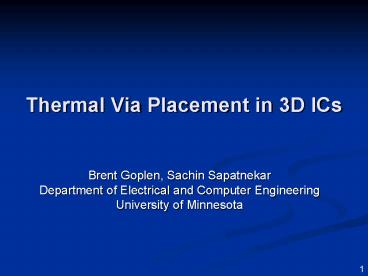Thermal Via Placement in 3D ICs - PowerPoint PPT Presentation
1 / 32
Title:
Thermal Via Placement in 3D ICs
Description:
[Das et al., ISVLSI, 2003] Generalized view. Bulk wafer. Metal level. of wafer 1. Layer 1 ... [Joyner, Zarkesh-Ha and Meindl, ASIC/SOC '01] from Intel. 5 ... – PowerPoint PPT presentation
Number of Views:35
Avg rating:3.0/5.0
Title: Thermal Via Placement in 3D ICs
1
Thermal Via Placement in 3D ICs
- Brent Goplen, Sachin Sapatnekar
- Department of Electrical and Computer Engineering
- University of Minnesota
2
Overview
- Introduction
- Simplified Example
- Formulation
- Results
- Conclusions
3
3D IC Using Wafer Bonding
Generalized view
Detailed view
SOI wafers with bulk substrate removed
Inter-layer bonds
1mm
Bulk wafer
Metal level of wafer 1
10mm
500mm
Device level 1
Adapted from Das et al., ISVLSI, 2003
4
Improvements and Obstacles of 3D ICs
- Benefits
- Reduced wirelength
- Lower power per transistor
- Decreased delay
- Higher packing densities
- Smaller chip areas
- Obstacles
- Processing technology
- Thermal issues
- Higher power densities
- Increased thickness
- Insulating materials
- 3D design tools
Joyner, Zarkesh-Ha and Meindl, ASIC/SOC 01
5
Methods of Mitigating Thermal Problems
6
Thermal Via Regions
- Thermal vias
- Electrically isolated vias
- Used for heat conduction
- Thermal via regions
- Only region where thermal vias are allowed
- Predictable obstacle for routing
- Variable density of thermal vias
7
Thermal Vias in 3D ICs
8
Benefits and Challenges
- Benefits
- Reduced temperatures
- Uses existing via fabrication
- Benefits 3D ICs more
- Challenges
- Creates obstacles to routing
- Where to put them?
- CAD tools needed
9
Overview
- Introduction
- Simplified Example
- Formulation
- Results
- Conclusions
10
Simplified Example
11
Simplified Example
12
Simplified Example
1
2
3
4
5
6
10W
7
8
9
10
13
Simplified Example
10W
14
Simplified Example
65oC
70oC
65oC
6oC
6oC
High Temps
10oC/W
10oC/W
59oC
81oC
59oC
10W
10oC/W
10oC/W
27oC
27oC
High temp drop
32oC
36oC
32oC
0oC
15
Simplified Example
65oC
70oC
65oC
10oC/W
10oC/W
60
59oC
81oC
59oC
32oC
36oC
32oC
0oC
16
Simplified Example
65oC
70oC
65oC
Use thermal gradient not temperature!
37
59oC
81oC
59oC
10oC/W
10oC/W
33
32oC
36oC
32oC
0oC
17
High Temperatures
Place Thermal Vias
18
High Thermal Gradients
Place Thermal Vias
19
- Impractical to place thermal vias individually
- Use arrangement of thermal vias instead
- Gives thermal via density value
- Changes the effective thermal conductivity
High Thermal Via Density
High Effective Thermal Conductivities
20
High Thermal Gradients
High Thermal Via Density
High Thermal Conductivity
21
Old Temperatures
Thermal Gradients
Thermal Conductivities
New Temperatures
22
Initial Temperatures
Thermal Gradients
Thermal Conductivities
New Temperatures
Thermal Via Densities
23
Mathematical Formulation
- Heat transfer within an element (region)
- K ?TP
- Assume P doesnt change between iterations
- Knew ?Tnew Kold ?Told
- Knew Kold (?Told / ?Tnew)
- Using the thermal gradient, g ?T /d,
- Knew Kold (gold / gnew)
- Let gnew slowly approach an ideal value, gideal
- gnew gideal (gold / gideal )a, 0 a 1
- Knew Kold (gold / gideal )1- a
- Update gideal using maximum temperature
- gideal gideal (Tmaxideal / Tmax)
24
Thermal Via Placement Algorithm
GIVEN IDEAL MAXIMUM TEMPERATURE Tmaxideal
25
Thermal Conductivities of Thermal Via Regions
26
Range of Temperature Values
- Midrange thermal via densities produce
- 47.1 lower maximum temperatures
- 28.3 lower average temperatures
27
Range of Temperature Values
- Midrange thermal via densities produce
- 47.1 lower maximum temperatures
- 28.3 lower average temperatures
28
Results
- Same maximum temperatures as with midrange via
densities - 1.8 higher average temperatures
- 11.9 thermal via density in thermal via regions
(1.2 in chip) - 50.3 lower than the midrange value
29
Results
- Same maximum temperatures as with midrange via
densities - 1.8 higher average temperatures
- 11.9 thermal via density in thermal via regions
(1.2 in chip) - 50.3 lower than the midrange value
30
Before Thermal Via Placement
31
After Thermal Via Placement
32
Conclusions
- Thermal vias have a greater effect in 3D ICs
- Thermal via regions provide regularity
- Efficient iterative method
- Uses thermal gradients to adjust thermal
conductivities - Ideal maximum temperature
- Use lowered value as an objective
- Minimizes use of thermal vias
- Vias are put where they make the most impact
- Reduces thermal resistance on heat conduction
paths































